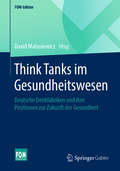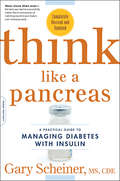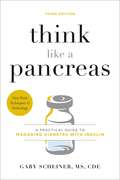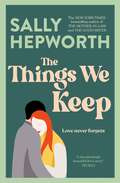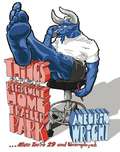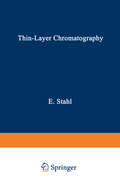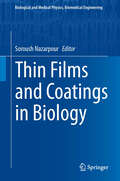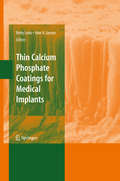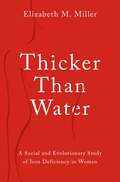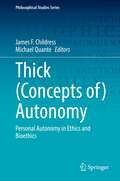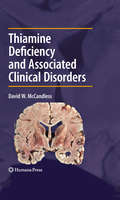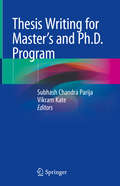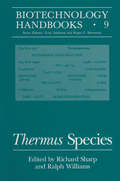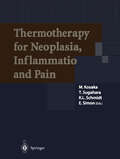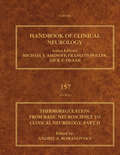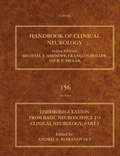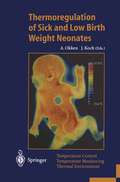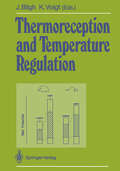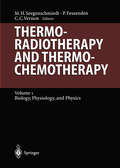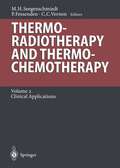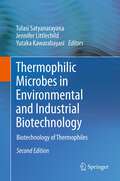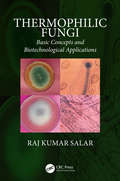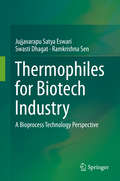- Table View
- List View
Think Tanks im Gesundheitswesen: Deutsche Denkfabriken und ihre Positionen zur Zukunft der Gesundheit (FOM-Edition)
by David MatusiewiczThink Tanks sind in den USA bereits fester Bestandteil und machtvolle Institutionen zur Beeinflussung von Wirtschaft und Politik. Hierzu zählt zum Beispiel die Heritage Foundation, der nachgesagt wird, dass sie maßgeblich die US-Gesundheitsreform "Obama Care" beeinflusst hat. Ebenso gibt es in Deutschland zahlreiche Think Tanks, wie zum Beispiel parteinahe Stiftungen, die sich auch mit gesundheitspolitischen Fragestellungen befassen. Daneben gibt es diverse Stiftungen aus der Industrie mit Engagements im Bereich der Gesundheit, aber es steigen zunehmend auch junge Initiativen in den Ring um die besten Ideen für die Zukunft der Gesundheit. Sie alle wollen frische Impulse für ein eingefahrenes Gesundheitswesen liefern und suchen unter anderem in Form von Positionspapieren oder auf der Bühne der großen gesundheitswirtschaftlichen Kongresse den Dialog mit den etablierten Entscheidern des Gesundheitssystems.Dieses Buch gibt einen ersten Überblick über die wichtigsten Think Tanks in Deutschland und beantwortet diese Fragen: Welche Denkfabriken im Gesundheitswesen und in der Medizin gibt es? Welche Themen greifen diese auf und welche halten sie für dringend? Wer steckt hinter der Finanzierung derartiger Plattformen? Und welchen Einfluss haben diese Denkfabriken?Ein Nachschlagewerk für alle, die kompetente Gesprächspartner für gesundheitspolitische Diskussionen am Puls der Zeit suchen.
Think Like a Pancreas: A Practical Guide to Managing Diabetes with Insulin--Completely Revised and Updated (Marlowe Diabetes Library)
by Gary ScheinerThe all-in-one, comprehensive resource for the millions of people with diabetes who use insulin, revised and updated.Few diabetes books focus specifically on the day-to-day issues facing people who use insulin. Diabetes educator Gary Scheiner provides the tools to "think like a pancreas" -- to successfully master the art and science of matching insulin to the body's ever-changing needs. Comprehensive, free of medical jargon, and packed with useful information not readily available elsewhere, such as: Day-to-day blood glucose control and monitoringDesigning an insulin program to best match your lifestyleUp-to date medication and technologyNew insulin formulations and combinationsand moreWith detailed information on new medications and technologies -- both apps and devices -- surrounding insulin, as well as new injection devices, and dietary recommendations, Think Like a Pancreas is the insulin user's go-to guide.
Think Like a Pancreas: A Practical Guide to Managing Diabetes with Insulin (Marlowe Diabetes Library)
by Gary ScheinerThe all-in-one, comprehensive resource for the millions of people with diabetes who use insulin, revised and updatedFew diabetes books focus specifically on the day-to-day issues facing people who use insulin. Diabetes educator Gary Scheiner provides the tools to "think like a pancreas" -- to successfully master the art and science of matching insulin to the body's ever-changing needs. Comprehensive, free of medical jargon, and packed with useful information not readily available elsewhere, such as: day-to-day blood glucose control and monitoring designing an insulin program to best match your lifestyleup-to date medication and technologynew insulin formulations and combinationsand moreWith detailed information on new medications and technologies -- both apps and devices -- surrounding insulin, as well as new injection devices, and dietary recommendations, Think Like a Pancreas is the insulin users go-to guide.
The Things We Keep: A Novel
by Sally HepworthThe Things We Keep is a moving and heartbreaking love story by Sally Hepworth. Just because you can't remember, doesn't mean you can't love . . .Anna Forster is thirty-eight years old and has started to suffer from the early stages of Alzheimer's. She knows that her family is doing what they believe to be best when they take her to an assisted living facility. But best can still hurt. What she also knows is that there's just one other resident her age at the facility – Luke.As her disease steals more and more of her memory, Anna fights to hold on to all that's left. What remains are her feelings for Luke. Before long the pair fall in love, despite the forces that are set against them.But when a tragic incident occurs, Luke and Anna's families decide to separate them. There is one person at the facility who can help the pair, but only if she's willing to risk everything for them . . .
Things to do in a Retirement Home Trailer Park...: When You're 29 and Unemployed
by Aneurin WrightA tour-de-force and eight years in the making, this is a powerful, superbly-drawn and deeply moving portrait of a young man coming to terms with his dying father, and with his own life, as he takes care of the old man in his final months. When Nye's father phones to wish him a happy birthday, and reveals he has been 'certified for hospice', Nye slumps down on the nearest doorstep in shock. Unemployment means that he is free to move in to the trailer park where his father lives, and assume the role of chief carer. Their daily schedule of pill counting and medical checks unfolds into an extraordinary world where the protagonist is a minotaur, his father a rhinoceros, social workers are sea turtles and mobile homes move atop gigantic elephants. Curious neighbours and medical and social care workers - whether man or beast - become their friends, and the family comes together once more. And as the old man battles against emphysema, his shortness of breath becomes more evident until his speech bubbles, previously charged with pithy comment, are mostly filled with pauses. Aneurin Wright's unforgettable debut is a universal tale of love and loss told in a wholly original way.
Thin Films and Coatings in Biology (Biological and Medical Physics, Biomedical Engineering)
by Soroush NazarpourThe surface of materials is routinely exposed to various environmental influences. Surface modification presents a technological challenge for material scientists, physicists, and engineers, particularly when those surfaces are subjected to function within human body environment. This book provides a comprehensive coverage of the major issues and topics dealing with interaction of soft living matter with the surface of implants. Fundamental scientific concepts are embedded through experimental data and a broad range of case studies. First chapters cover the basics on biocompatibility of many different thin films of metals, alloys, ceramics, hydrogels, and polymers, following with case studies dealing with orthopedic and dental coatings. Next, a novel and low-cost coating deposition technique capable of production of several types of nanostructures is introduced through simple calculations and several illustrations. Moreover, chapter 6 and 7 present important topics on surface treatment of polymers, which is a subject that has seen many developments over the past decade. The last chapters target mainly the applications of coatings in biology such as in bio-sensing, neuroscience, and cancer detection. With several illustrations, micrographs, and case studies along with suitable references in each chapter, this book will be essential for graduate students and researchers in the multidisciplinary field of bio-coatings.
Thin Calcium Phosphate Coatings for Medical Implants
by Betty León John A. JansenThis book presents for the first time, the scattered novel results that have been achieved in very recent years in study on various thin calcium phosphate coatings produced by very diverse techniques. The comparison of thin calcium phosphate coatings with the thick plasma-sprayed ones is also included in the book. Readers will find a comprehensive book reviewing the state-of-the-art of the field with critical assessment of the achievements of the different preparation techniques.
Thicker Than Water: A Social and Evolutionary Study of Iron Deficiency in Women
by Elizabeth M. MillerA powerful and critical investigation of iron deficiency in women throughout evolutionary history and in our current society Women of the world are beset by a hidden hunger: iron deficiency. Up to 40% of reproductive-aged women across the globe have iron deficiency anemia, and it contributes to 20% of maternal deaths. Despite these dire statistics, women are not routinely screened for iron deficiency. Iron deficiency has been used as a tool to control, categorize, and even ignore women and their suffering. Biomedical remedies - mostly iron supplementation - are unequally and indifferently applied to global populations of women. Thicker Than Water explores the reasons women are especially vulnerable, using evolutionary theory and social theory to understand the causes and consequences of iron deficiency in women. Contrary to popular belief, homeostasis protects the iron stores of women from iron loss during menstruation. Women's iron metabolism has evolved to balance the benefits and danger of iron, protecting vulnerable embryos against excessive iron at the cost of reduced iron stores for themselves. This balancing act is threatened when social circumstances prevent women from accessing the dietary iron they need. Exploring how race, poverty, and gender are entangled with women's evolved bodies, Dr. Elizabeth M. Miller brings a new anthropological lens to this issue that deeply affects and even threatens women's lives. Ultimately, this book shows that women's evolved bodies - optimized to protect themselves and their offspring - are devastated by structural forces beyond their control.
Thicker Than Water: A Social and Evolutionary Study of Iron Deficiency in Women
by Elizabeth M. MillerA powerful and critical investigation of iron deficiency in women throughout evolutionary history and in our current society Women of the world are beset by a hidden hunger: iron deficiency. Up to 40% of reproductive-aged women across the globe have iron deficiency anemia, and it contributes to 20% of maternal deaths. Despite these dire statistics, women are not routinely screened for iron deficiency. Iron deficiency has been used as a tool to control, categorize, and even ignore women and their suffering. Biomedical remedies - mostly iron supplementation - are unequally and indifferently applied to global populations of women. Thicker Than Water explores the reasons women are especially vulnerable, using evolutionary theory and social theory to understand the causes and consequences of iron deficiency in women. Contrary to popular belief, homeostasis protects the iron stores of women from iron loss during menstruation. Women's iron metabolism has evolved to balance the benefits and danger of iron, protecting vulnerable embryos against excessive iron at the cost of reduced iron stores for themselves. This balancing act is threatened when social circumstances prevent women from accessing the dietary iron they need. Exploring how race, poverty, and gender are entangled with women's evolved bodies, Dr. Elizabeth M. Miller brings a new anthropological lens to this issue that deeply affects and even threatens women's lives. Ultimately, this book shows that women's evolved bodies - optimized to protect themselves and their offspring - are devastated by structural forces beyond their control.
Thick: Personal Autonomy in Ethics and Bioethics (Philosophical Studies Series #146)
by James F. Childress Michael QuanteThis book explores, in rich and rigorous ways, the possibilities and limitations of “thick” (concepts of) autonomy in light of contemporary debates in philosophy, ethics, and bioethics. Many standard ethical theories and practices, particularly in domains such as biomedical ethics, incorporate minimal, formal, procedural concepts of personal autonomy and autonomous decisions and actions. Over the last three decades, concerns about the problems and limitations of these “thin” concepts have led to the formulation of “thick” concepts that highlight the mental, corporeal, biographical and social conditions of what it means to be a human person and that enrich concepts of autonomy, with direct implications for the ethical requirement to respect autonomy. The chapters in this book offer a wide range of perspectives on both the elements of and the relations (both positive and negative) between “thin” and “thick” concepts of autonomy as well as their relative roles and importance in ethics and bioethics. This book offers valuable and illuminating examinations of autonomy and respect for autonomy, relevant for audiences in philosophy, ethics, and bioethics.
Thiamine Deficiency and Associated Clinical Disorders (Contemporary Clinical Neuroscience)
by David W. McCandlessThiamine deficiency and related clinical disorders represent an intriguing area of both basic and clinical investigation. Modern imaging strategies have facilitated the rapid treatment, and potential reversal of these clinical disorders. The fusion of laboratory and clinical knowledge serve as an example of how research can translate to successful treatment. The goal of Thiamine Deficiency and Related Clinical Disorders is to bring together cogent results from basic and clinical investigation and to stimulate further investigations in these areas. This data will be useful to neurologists, internists, nutritionists, biochemists, neurochemists, neuroscientists, and others with interest in thiamine deficiency.
Thesis Writing for Master's and Ph.D. Program
by Subhash Chandra Parija Vikram KateThis book on Thesis Writing for Master’s and Ph.D. program focuses on the difficulties students encounter with regard to choosing a guide; selecting an appropriate research title considering the available resources; conducting research; and ways to overcome the hardships they face while researching, writing and preparing their dissertation for submission. Thesis writing is an essential skill that medical and other postgraduates are expected to learn during their academic career as a mandatory partial requirement in order to receive the Master’s degree. However, at the majority of medical schools, writing a thesis is largely based on self-learning, which adds to the burden on students due to the tremendous amount of time spent learning the writing skills in addition to their exhausting clinical and academic work. Due to the difficulties faced during the early grooming years and lack of adequate guidance, acquiring writing skills continues to be a daunting task for most students. This book addresses these difficulties and deficiencies and provides comprehensive guidance, from selecting the research title to publishing in a scientific journal.
Thermus Species (Biotechnology Handbooks #9)
by Richard Sharp Ralph WilliamsThere is considerable interest in thermophile microorganisms, in their environments, their ability to survive at temperatures which normally denature proteins, but more importantly, as a valuable resource for bio technology. The first reported isolation of Thermus by Tom Brock was in 1969. This initiated the present era of thermophilic research with the realization that where liquid water is available, there may be no limits to the temper ature at which microorganisms can grow. Considerable research into the ecology, physiology, metabolism, and thermostable enzymes of thermo philes has led to their evaluation for a range of industrial and commercial processes. The past fifteen years have been an explosive period of dis covery of many new genera and species, including the descriptions of a new fundamental kingdom-the Archaea. Much of the current research has been focused on the Archaea; but it is significant that during this period, the original type strain YT-l of Thermus aquaticus described by Brock has provided a major step forward in molecular biology. DNA polymerase from strain YT-I has proved to be the major success in the commercialization of enzymes from thermophilic microorganisms to date. The ease with which Thermus strains can be handled in laboratories without specialized equipment, together with the large investment in de scribing their structure, metabolism, and genetics, should ensure a con tinuing effort in Thermus research.
Thermotherapy for Neoplasia, Inflammation, and Pain
by K. L. Schmidt E. Simon M. Kosaka T. SugaharaThis book provides a comprehensive overview of the multitude of different forms of thermotherapy in connection with aspects of thermal physiology and cell biology. The aim is to elucidate the scientific background of therapeutic actions and to promote effective new applications at the beginning of the 21st century. Significant to these purposes is cooperation between experts in the fields of thermal biology, hyper thermic oncology, rheumatology, and balneology, as represented by the editors. Emphasis has been placed on a balanced choice of contributions, in the hope that this will enable the reader to draw helpful connections between the principles and prac tice of thermotherapy. It is apparent that a wealth of published data exists concerning thermotherapy on the one hand and thermal physiology on the other. However, in the former field empirical aspects of therapeutic usefulness prevail, while in the latter, aspects of basic science are in the foreground. Accordingly, the sources where published data may be found are quite different and as a consequence many findings of potential mutual interest published in medical journals have gone unnoticed by readers of physio logical journals, and vice versa. It is hoped that this book will bridge the gap and encourage researchers' efforts to integrate the available knowledge to attain optimal coordination of clinical and theoretical aspects.
Thermoregulation Part II: From Basic Neuroscience to Clinical Neurology (ISSN #Volume 157)
by Andrej A. RomanovskyThermoregulation, Part II: From Basic Neuroscience to Clinical Neurology, Volume 155, not only reviews how body temperature regulation changes in neurological diseases, but also how this aspect affects the course and outcomes of each disease. Other sections of the volume review three therapeutic approaches that are aimed at manipulating body temperature, including induced hypothermia, induced hyperthermia and antipyretic therapy. The book is comprised of nine sections across two volumes, five dealing with the basic aspects of body temperature regulation and four dealing with the clinical aspects. Basic sections cover the Thermoregulation system, Thermoreceptors, Thermoeffectors, Neural pathways, and Thermoregulation as a homeostatic function. In addition, the book covers the physiology and neuroanatomy of the thermoregulation system and provides descriptions of how the regulation of body temperature intervenes with other physiological functions (such as sleep, osmoregulation, and immunity), stress, exercise and aging. Basic sections serve as an introduction to the four clinical sections: Body Temperature, Clinical Significance, Abnormal Body Temperature, Thermoregulation in Neurological Disease and Therapeutic Interventions.Presents a clear, logical pathway from the fundamental physiology of thermoregulation, through neurobiology, to clinical applications and diseaseEnables researchers and clinicians to better understand the value of temperature measurement in disease and the use of temperature as a therapy Integrates content from a broad field of research, including topics on the molecular physiology of temperature receptors, to the management of accidental hypothermia
Thermoregulation Part I: From Basic Neuroscience to Clinical Neurology (ISSN #Volume 156)
by Andrej A. RomanovskyThermoregulation, Part I: From Basic Neuroscience to Clinical Neurology, Volume 154, not only reviews how body temperature regulation changes in neurological diseases, but also how this aspect affects the course and outcomes of each disease. Other sections of the volume review three therapeutic approaches that are aimed at manipulating body temperature, including induced hypothermia, induced hyperthermia and antipyretic therapy. The book is comprised of nine sections across two volumes, five dealing with the basic aspects of body temperature regulation and four dealing with the clinical aspects. Basic sections cover the Thermoregulation system, Thermoreceptors, Thermoeffectors, Neural pathways, and Thermoregulation as a homeostatic function. In addition, the book covers the physiology and neuroanatomy of the thermoregulation system and provides descriptions of how the regulation of body temperature intervenes with other physiological functions (such as sleep, osmoregulation, and immunity), stress, exercise and aging. Basic sections serve as an introduction to the four clinical sections: Body Temperature, Clinical Significance, Abnormal Body Temperature, Thermoregulation in Neurological Disease and Therapeutic Interventions.Presents a clear, logical pathway from the fundamental physiology of thermoregulation, through neurobiology, to clinical applications and diseaseEnables researchers and clinicians to better understand the value of temperature measurement in disease and the use of temperature as a therapy Integrates content from a broad field of research, including topics on the molecular physiology of temperature receptors, to the management of accidental hypothermia
Thermoregulation of Sick and Low Birth Weight Neonates: Temperature Control. Temperature Monitoring. Thermal Environment
by Albert Okken Jochim KochIn this book, the editors have succeeded in bringing together many renowned authors in the field. They discuss the physical principles of heat transfer in various heating devices used in neonatal care for temperature distribution throughout the body, such as incubators, open radiant warmers, and heated mattresses, as well as the significance of simultaneously monitoring core and periphal temperature. Alongside a treatment of extreme thermal conditions, contributions also pinpoint the optimal thermal environment. An invaluable aid for all those working in the field of neonatal care, including doctors, scientists, students, and nurses.
Thermoreception and Temperature Regulation
by H. A. Braun K. Brück G. HeldmaierAs indicated in the Preface, the contributions to this volume are based upon the papers presented at the symposium on Thermoreceptors and Temperature Regula tion held in July 1988 at the Institute of Physiology of the University of Marburg (Federal Republic of Germany) to celebrate and commemorate the life and achievements of HERBERT HENSEL, who directed that Institute from 1955 until his death in 1983, and whose most notable and significant contributions to thermo physiology were in the areas of the properties and characteristics of thermo sensors, mammalian thermoregulation more generally, and the psychophysiology of ther mal sensation. All the papers in this volume deal, to a greater or lesser extent, with these discernibly different but closely allied aspects of mammalian physiology. The editors have sought to achieve cohesion, flow, and balance both in the contributed articles and in their order of presentation, without either large gaps or redundancies in the coverage of the recent advances in the understanding of thermoreceptors and thermoregulation. At the same time we have sought to avoid such a degree of editorial control as to destroy the individuality of the contributions, and the judgements upon which they were based. We have also sought to look both backwards and forwards, and to include some legitimate extension of the con sideration of thermosensitivity and thermoregulation into such areas as climatic adaptation and fever. Hence the "greater or lesser" of the closeness of this series of papers to HERBERT HENSEL'S scientific interests.
Thermoradiotherapy and Thermochemotherapy: Biology, Physiology, Physics (Medical Radiology)
by J. C. Bolomey P. Burgman I. B. Choi J. Crezee O. Dahl M. W. Dewhirst C. J. Diederich R. Felix K. Hynynen D. K. Kelleher A.W.T. Konings J.J.W. Lagendijk D. Le Bihan E. R. Lee G. C. Li S. Mizushina J. Mooibroeck J. Nadobny B. S. Nah A. Nussenzweig R. Olmi J. L. Osborn K. D. Paulsen D. M. Prescott D. I. Roos S. K. Sahu C. J. Schneider M. Seebass M. H. Seegenschmiedt C. W. Song P. R. Stauffer C. Streffer J.D.P. van Dijk G.C. van Roon P. W. Vaupel C. C. Vernon A. Visser F. M. Waterman P. WustHyperthermia has been found to be of great benefit in combination with radiation therapy or chemotherapy in the management of patients with difficult and com plicated tumor problems. It has been demonstrated to increase the efficacy, of ionising radiation when used locally but also has been of help in combination with systemic chemotherapy where hyperthermia is carried out to the total body. Problems remain with regard to maximizing the effects of hyperthermia as in fluenced by blood flow, heat loss, etc. The present volume defines the current knowledge relative to hyperthermia with radiation therapy and/or chemotherapy, giving a comprehensive overview of its use in cancer management. Philadelphia/Hamburg, June 1995 L.W. BRADY H.-P. HEILMANN Preface In an attempt to overcome tumor resistance, hypoxia, or unfavorable tumor condi tions, oncological research has come to focus on gene therapy, immunotherapy, new cytotoxic agents, and increasingly sophisticated radiotherapy. Radiation research has been directed towards heavy particle therapy and modification of the radiation response by either protecting or sensitizing agents. Improved dose localization using rotational or conformal strategies has also been implemented. Recently, changes in radiation fractionation schedules have shown promise of better results. Hyperthermia in cancer therapy can be viewed similarly as another means to increase the sensitivity of tumors to radio- and chemotherapy.
Thermoradiotherapy and Thermochemotherapy: Volume 2: Clinical Applications (Medical Radiology)
by L. W. Brady H. P. HeilmannHyperthermia has been found to be of great benefit in combination with radiation therapy or chemotherapy in the management of patients with difficult and com plicated tumor problems. It has been demonstrated to increase the efficacy of ionizing radiation when used locally but also has been of help in combination with systemic chemotherapy where hyperthermia is carried out to the total body. Triple modality (thermo-chemo-radiotherapy) or other treatment combinations have not been fully evaluated and may demonstrate extended clinical applications in the future. Problems remain with regard to maximizing the effects of hyperthermia as they are influenced by a variety of external and intrinsic factors including bloodflow, microenvironment etc. While the previous volume has summarized more theoretical aspects of hyper thermia, i.e. biology, physiology and physics, the present volume compiles the current knowledge relative to the clinical applications of hyperthermia in combina tion with radiation therapy and/or chemotherapy, providing a comprehensive over view of its use in cancer management.
Thermophilic Microbes in Environmental and Industrial Biotechnology: Biotechnology of Thermophiles
by Tulasi Satyanarayana, Jennifer Littlechild and Yutaka KawarabayasiThe existence of life at high temperatures is quiet fascinating. At elevated temperatures, only microorganisms are capable of growth and survival. Many thermophilic microbial genera have been isolated from man-made (washing machines, factory effluents, waste streams and acid mine effluents) and natural (volcanic areas, geothermal areas, terrestrial hot springs, submarine hydrothermal vents, geothermally heated oil reserves and oil wells, sun-heated litter and soils/sediments) thermal habitats throughout the world. Both culture-dependent and culture-independent approaches have been employed for understanding the diversity of microbes in hot environments. Interest in their diversity, ecology, and physiology has increased enormously during the past few decades as indicated by the deliberations in international conferences on extremophiles and thermophiles held every alternate year and papers published in journals such as Extremophiles. Thermophilic moulds and bacteria have been extensively studied in plant biomass bioconversion processes as sources of industrial enzymes and as gene donors. In the development of third generation biofuels such as bioethanol, thermophilic fungal and bacterial enzymes are of particular interest. The book is aimed at bringing together scattered up-to-date information on various aspects of thermophiles such as the diversity of thermophiles and viruses of thermophiles, their potential roles in pollution control and bioremediation, and composting.
Thermophilic Fungi: Basic Concepts and Biotechnological Applications
by Raj Kumar SalarThis book aims to fill the gap by documenting thermophilic fungi discovered over the past five decades. The chapters spans from covering basic aspects, taxonomy and classification including molecular phyologeny and biotechnological applications of thermophilic fungi.
Thermophilic Fungi: Basic Concepts and Biotechnological Applications
by Raj Kumar SalarThis book aims to fill the gap by documenting thermophilic fungi discovered over the past five decades. The chapters spans from covering basic aspects, taxonomy and classification including molecular phyologeny and biotechnological applications of thermophilic fungi.
Thermophiles for Biotech Industry: A Bioprocess Technology Perspective
by Jujjavarapu Satya Eswari Swasti Dhagat Ramkrishna SenThermophiles and hyperthermophiles exhibit great biotechnological potential, as they can be utilized in processes which require higher temperatures. This book comprehensively deals with all the aspects of thermophiles, starting from the source of these organisms to their latest applications. In addition it presents a compilation of all compounds produced by various thermophilic microorganisms. Due to their application in everyday life, the demands of enzymes that can work at higher temperature have been increasing. In order to keep pace with the increasing demand the industries have to search novel thermophiles producing their product of interest. Hence, this book will be of value for industries working on various biochemical products produced by these thermophiles as well as for scientists and research scholars working on microbiology and products derived from microorganisms.
